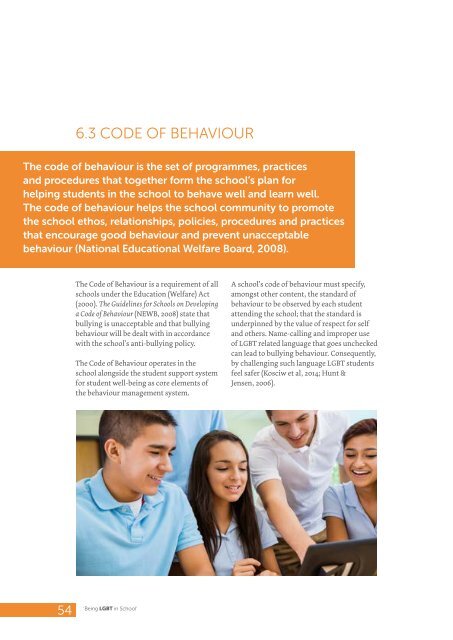‘BEING LGBT IN SCHOOL’
GLEN__Being_LGBT_in_School_10_Feb_2016_Web_3
GLEN__Being_LGBT_in_School_10_Feb_2016_Web_3
You also want an ePaper? Increase the reach of your titles
YUMPU automatically turns print PDFs into web optimized ePapers that Google loves.
6.3 CODE OF BEHAVIOUR<br />
The code of behaviour is the set of programmes, practices<br />
and procedures that together form the school’s plan for<br />
helping students in the school to behave well and learn well.<br />
The code of behaviour helps the school community to promote<br />
the school ethos, relationships, policies, procedures and practices<br />
that encourage good behaviour and prevent unacceptable<br />
behaviour (National Educational Welfare Board, 2008).<br />
The Code of Behaviour is a requirement of all<br />
schools under the Education (Welfare) Act<br />
(2000). The Guidelines for Schools on Developing<br />
a Code of Behaviour (NEWB, 2008) state that<br />
bullying is unacceptable and that bullying<br />
behaviour will be dealt with in accordance<br />
with the school’s anti-bullying policy.<br />
The Code of Behaviour operates in the<br />
school alongside the student support system<br />
for student well-being as core elements of<br />
the behaviour management system.<br />
A school’s code of behaviour must specify,<br />
amongst other content, the standard of<br />
behaviour to be observed by each student<br />
attending the school; that the standard is<br />
underpinned by the value of respect for self<br />
and others. Name-calling and improper use<br />
of <strong>LGBT</strong> related language that goes unchecked<br />
can lead to bullying behaviour. Consequently,<br />
by challenging such language <strong>LGBT</strong> students<br />
feel safer (Kosciw et al, 2014; Hunt &<br />
Jensen, 2006).<br />
54<br />
‘Being <strong>LGBT</strong> in School’


